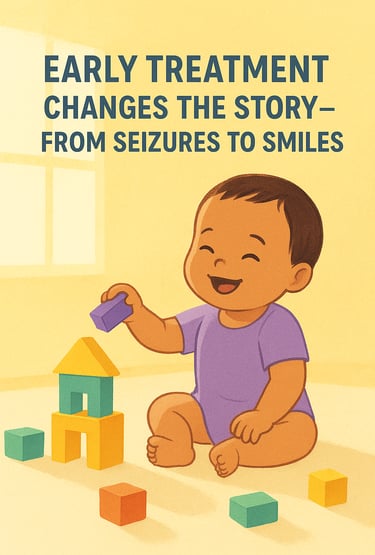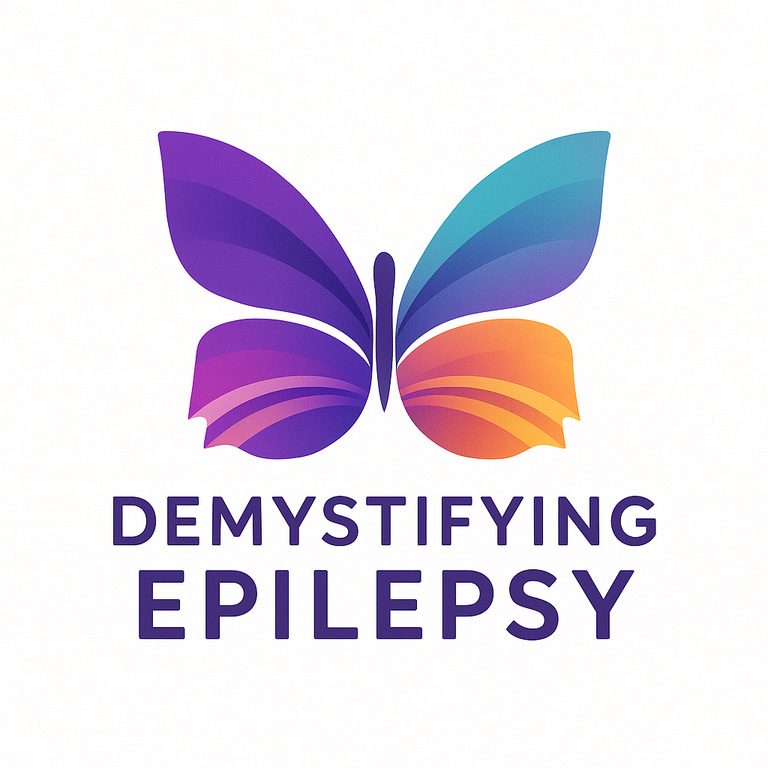Understanding West Syndrome (Infantile Spasms): When Some Movements Signal Something Bigger
West syndrome, also known as infantile spasms, is a rare but serious epilepsy syndrome that affects infants, often appearing as subtle, repetitive movements mistaken for normal baby behavior. This blog explores the signs, causes, and treatments of West syndrome through the story of Jessie, a once-thriving baby whose sudden “head drops” revealed something far more concerning. Learn how early recognition and treatment can make a life-changing difference, why these seizures are considered a medical emergency, and what parents and caregivers should know about this condition.
Dr. Clotilda Chinyanya
11/18/20254 min read


Meet Jessie: A Story of Hope
Jessie was a healthy, happy baby smiling early, babbling often, and rolling over before five months. Then her mother noticed something odd: Jessie’s head would dip forward suddenly, almost like a quick nod. At first it seemed harmless, but the movements grew stronger. Her head bent toward her knees, her arms stiffened, and then she relaxed upright again, repeatedly in clusters.
These episodes came several times a day. Jessie sometimes cried afterward, looking frightened and exhausted. Soon, she stopped babbling as much. Her bright eyes seemed distant. The lively baby who once reached eagerly for toys now seemed lost in moments of stillness.
Her parents sought help, and an EEG showed a chaotic pattern called hypsarrhythmia. Jessie was diagnosed with West syndrome, a rare and serious form of epilepsy also known as infantile spasms. The “head bobs” that seemed like a quirk were seizures disrupting her brain’s development.
Treatment with anti-seizure medications was started immediately. Gradually, the spasms lessened. The first day Jessie went a morning without one, her mother cried with relief. In time, Jessie’s smile returned, smaller, slower, but real.
Jessie’s story reminds us that early recognition and treatment of infantile spasms can change a child’s future. A brief “head drop” may not seem urgent, but in babies, it can be a silent signal that the brain needs help fast.
What Is West Syndrome?
West syndrome is an age-specific epilepsy syndrome, often beginning in infancy (typically 3–12 months of age). It falls under the broader category of Infantile Epileptic Spasms Syndrome (IESS), which is defined by the triad of: epileptic spasms, the EEG pattern hypsarrhythmia, and developmental plateauing or regression. ILAE
In plain terms, West syndrome means that seizures are not just brief episodes, they can impact a baby’s brain development. The spasms tend to occur in clusters, and early developmental skills may be lost or delayed. While each individual spasm might last only a second or two, the frequency and clustering make them a medical emergency.
Recognizing the Spasms
Identifying infantile spasms early can be difficult because the movements may be subtle or mistaken for other things such as colic or startle reflex. Key features include:
Sudden bending forward (flexor type) or extension of the body (extensor type), often called “jackknife seizures.”
Arms may fling out or up, knees pull in, or back may arch.
Each spasm is brief (1–2 seconds) but occurs in clusters (“episodes of dozens”) often shortly after waking.
Babies may cry or make a startling noise, but they often resume normal behavior immediately afterward.
Spasms are a neuro-emergency: rapid diagnosis and treatment significantly improve outcomes.
If you see repeated short jerks in a baby, especially after waking or following a fever or illness, ask your pediatric neurologist about the possibility of infantile spasms. A video recording of the episodes can be very helpful.
What Causes West Syndrome?
There is no single cause of West syndrome; rather, it can result from a variety of underlying issues:
Structural brain abnormalities (e.g., brain injury, malformations, tuberous sclerosis)
Chromosomal disorders (such as Down or Miller-Dieker syndromes)
Genetic mutations (including ARX, CDKL5, STXBP1, and others)
Metabolic disorders or cryptogenic (unknown cause) in about one-third of cases
Around two-thirds of infants diagnosed with IESS/West syndrome have an identifiable underlying cause. The remaining one-third may have no known cause even after thorough testing. Early and comprehensive evaluation matters because the cause influences both treatment and prognosis.
Why Early Treatment Matters
Because the spasms and associated abnormal brain activity (hypsarrhythmia) can interfere with normal brain development, each single day counts. Delayed treatment is linked to worse outcomes in cognitive development and epilepsy control. Treatment goals include stopping the spasms, normalizing the EEG pattern, preventing further developmental loss, and optimizing long-term outcomes. Evidence supports starting first-line therapy as soon as the syndrome is diagnosed.
Treatment Options
Anti-Seizure Medications: Your doctor will use first line treatment options and if there is no favorable response, could move to the second line ASMs.
Ketogenic diet: A high-fat, low‐carbohydrate diet may benefit some children with refractory spasms.
Epilepsy surgery: In selected infants with a focal structural cause causing spasms, surgery may be considered, though this is less common in typical West syndrome.
Rescue Plans & Long-Term Care
Because of risk for status epilepticus and developmental regression, every child should have a seizure action plan, rescue medications, and multidisciplinary support: neurologist, developmental pediatrician, therapists (OT/PT/Speech), early-intervention programs.
What the Outlook Looks Like
The prognosis for West syndrome is highly variable and depends on the underlying cause, how rapidly treatment is started, and how well the spasms and EEG abnormalities are controlled.
Some children who were developing typically before onset and receive prompt effective treatment may have milder developmental impacts and better intellectual outcomes (10-20% may achieve near-normal development).
Many children will have ongoing epilepsy beyond infancy, and may evolve into other epilepsy syndromes such as Lennox-Gastaut syndrome or focal epilepsies.
Early developmental assessment, educational planning, and therapy are crucial to optimize outcomes.
Jessie’s Path Forward
Back to Jessie: After her diagnosis, her care team quickly organized treatment, thanks to early detection. Her spasms decreased significantly within weeks, and a follow-up EEG showed improvement. Her parents engaged therapists and the early-intervention programme. At age two, Jessie still uses medications, but she’s walking steadily, playing with toys again, and making new words. Her team knows that regular monitoring and developmental support will continue for years, but Jessie’s path is hopeful.
Supporting Families: What Parents Can Do
Record the spells. A video of the events is often the clearest way to convey the issue to a clinician.
Ask for urgent referral. If you notice clusters of jerks in a baby or plateauing development, ask for a pediatric neurology evaluation.
Request specific tests. EEG with video, MRI, genetic and metabolic panels help determine cause and guide treatment.
Choose a therapy-savvy team. Infantile spasms require a specialist neurology team and early-intervention programme.
Educate & advocate. Get seizure action plans, talk to teachers or therapy providers, monitor vision (especially if using vigabatrin), monitor development actively.
Connect. Parent networks, epilepsy foundations, and support groups can provide community and resources.
Final Thoughts: Hope Through Early Action
West syndrome is a serious and urgent condition, but early recognition and swift, appropriate treatment give children like Jessie a chance for more than just survival. They give them a chance to thrive. While the path may be longer and care more intensive than typical childhood, the combination of early intervention, expert care, and family advocacy opens possibilities for growth, learning, and joy.
For families dealing with early-onset seizures, the message is: don’t wait. Observe, record, seek help, and ask the question: Could these be infantile spasms? Because the sooner the answer comes, the sooner the hope begins.
Choose knowledge:
